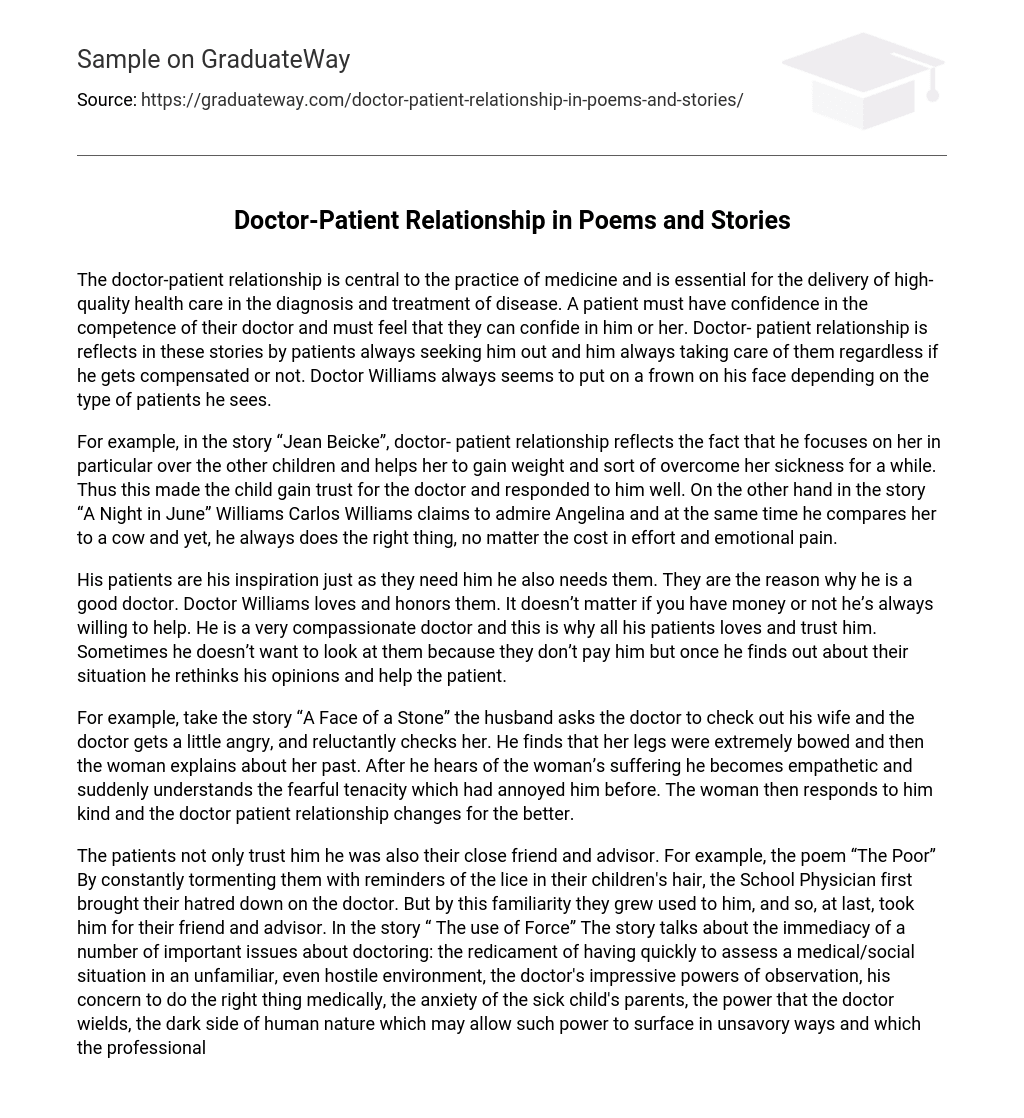The doctor-patient relationship is essential in medical practice and plays a crucial role in delivering effective healthcare for disease diagnosis and treatment. Patients must have trust in their doctor’s expertise and feel at ease sharing their concerns. The narratives depict this bond as patients consistently seek out Doctor Williams, who provides care regardless of payment. Doctor Williams’ facial expressions appear to be influenced by the types of patients he interacts with.
In the story “Jean Beicke”, the doctor-patient relationship is focused on her individually, helping her overcome her sickness and gain weight. This fosters trust and a positive response from the child. However, in “A Night in June”, Williams Carlos Williams both admires Angelina and compares her to a cow, but consistently acts in a morally upright manner despite the emotional toll it may take.
Doctor Williams finds inspiration in his patients, and they are equally dependent on him. They serve as the motivation behind his proficiency as a doctor. Regardless of their financial status, he sincerely cares for and respects them, always ready to provide assistance. His patients love and trust him because of his exceptional compassion. Although initially hesitant about treating those who cannot pay, he changes his mind after learning about their circumstances and offers them the necessary help.
In the story “A Face of a Stone”, the husband requests the doctor to examine his wife, causing the doctor to become slightly angry but ultimately comply. During the examination, the doctor discovers that the wife’s legs are severely bowed. The wife then shares details about her past, explaining the cause of her condition. Upon hearing about her suffering, the doctor develops empathy and realizes the previously annoying determination she exhibited. The woman responds kindly to him, leading to a positive transformation in their doctor-patient relationship.
The patients not only trust him, but he is also their close friend and advisor. In the poem “The Poor,” the School Physician brings their hatred down on the doctor by constantly tormenting them with reminders of the lice in their children’s hair. However, through this familiarity, they become used to him and ultimately consider him their friend and advisor. Several important issues about doctoring are discussed in the story “The Use of Force.” These include the challenge of quickly assessing a medical/social situation in an unfamiliar and hostile environment, the doctor’s impressive powers of observation, his dedication to making the right medical decisions, anxiety experienced by sick child’s parents, power wielded by the doctor, potential dark side of human nature leading to unsavory uses of such power, and struggles faced by William Carlos Williams in his stories.
Despite facing criticism of his wife and colleagues, the protagonist contended with the absence of compensation for his efforts in the story “The Girl with a Pimply Face,” where he provided essential care for a baby’s stabilized heart. His spouse and colleagues doubted the legitimacy of the baby’s family, labeling them as fraudulent and asserting that he would never receive payment. In the narrative “Old Doc Rivers,” the protagonist is depicted as an experienced physician who leans towards expeditious decisions and prompt actions. Although known for struggling with alcohol and drugs, the local community perceived him as authoritative, often seeking his aid when all other options proved fruitless.
Williams observed that Rivers, despite being drugged, poses a threat to his patients. However, Williams also admires Rivers’ medical abilities to some degree and the reassurance he instills in his patients. This story showcases the influence of a physician who lacks proficiency and updated knowledge in the patient-doctor dynamic. Nevertheless, his charismatic power often proves effective in promoting healing. Helplessly, Williams witnessed his colleague’s demise due to drug addiction. The poem “The Birth” captures the ordinary experiences of a doctor involved in delivering babies.
This poem illustrates the laborious process of a forty-year-old woman named Para delivering a baby. It emphasizes the duration and pain of the contractions experienced by the woman. Finally, the baby, named Madonna, weighing thirteen and a half pounds, begins to move towards the birth canal. The doctor’s impatience with the delivery process exhausts him. In addition, the poem touches upon the doctor’s struggle to find balance between his profession as a doctor and his passion as a writer/poet. According to William, he claims that practising medicine is not burdensome for him. He believes that it nourishes the body while writing, despite occasional complaints, fulfills him. Although he desires more time for writing, he would never forget the healing and inspiring moments of being a doctor as it runs in his blood and holds a special place in his heart. He values assisting and relieving people’s pain, even though his patients often cause frustration and he is not always compensated for his efforts. In short, William Carlos wouldn’t choose any other path despite these challenges. These are the themes and struggles portrayed in the stories.





